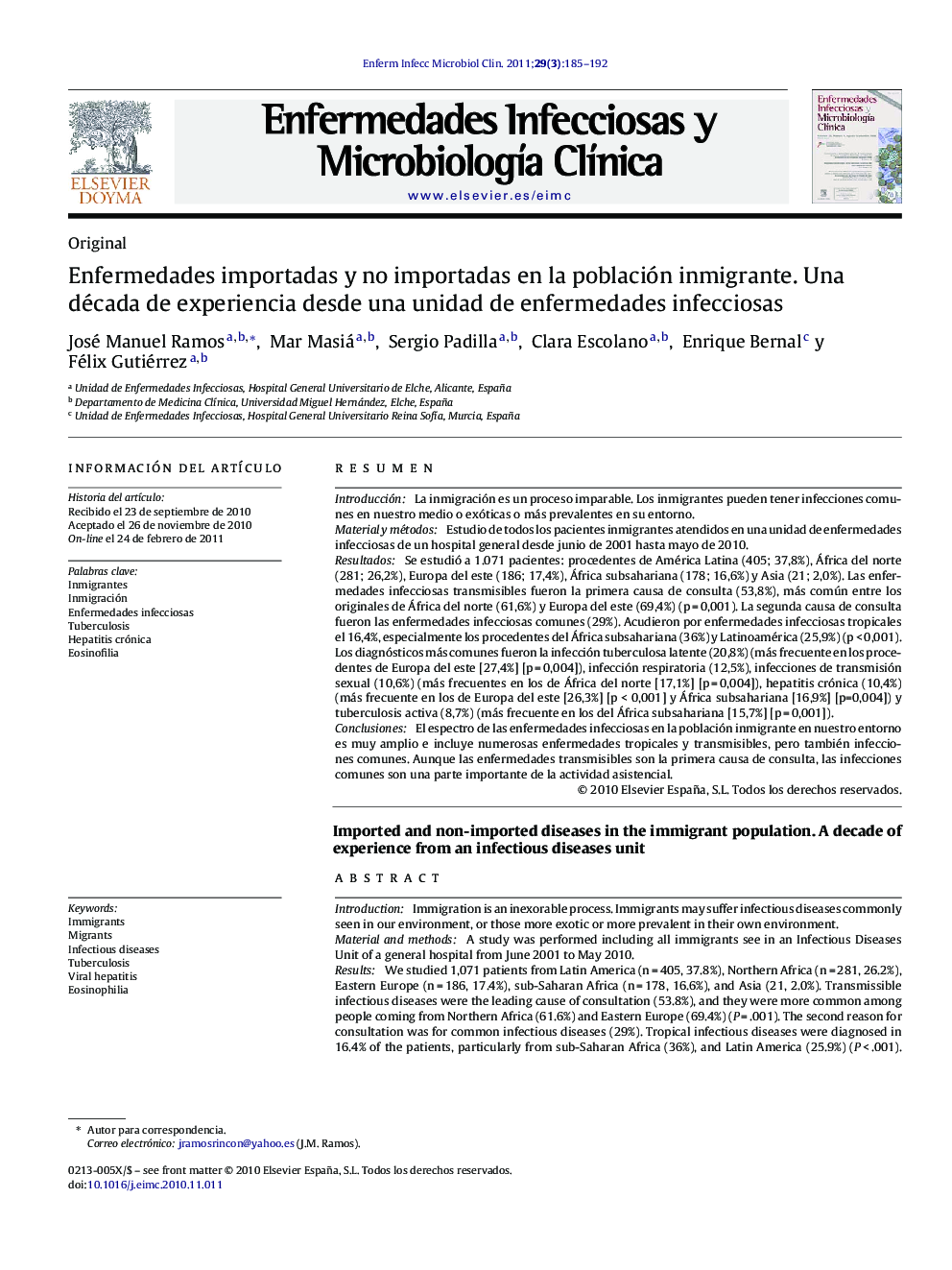| کد مقاله | کد نشریه | سال انتشار | مقاله انگلیسی | نسخه تمام متن |
|---|---|---|---|---|
| 3401840 | 1222686 | 2011 | 8 صفحه PDF | دانلود رایگان |

ResumenIntroducciónLa inmigración es un proceso imparable. Los inmigrantes pueden tener infecciones comunes en nuestro medio o exóticas o más prevalentes en su entorno.Material y métodosEstudio de todos los pacientes inmigrantes atendidos en una unidad de enfermedades infecciosas de un hospital general desde junio de 2001 hasta mayo de 2010.ResultadosSe estudió a 1.071 pacientes: procedentes de América Latina (405; 37,8%), África del norte (281; 26,2%), Europa del este (186; 17,4%), África subsahariana (178; 16,6%) y Asia (21; 2,0%). Las enfermedades infecciosas transmisibles fueron la primera causa de consulta (53,8%), más común entre los originales de África del norte (61,6%) y Europa del este (69,4%) (p = 0,001). La segunda causa de consulta fueron las enfermedades infecciosas comunes (29%). Acudieron por enfermedades infecciosas tropicales el 16,4%, especialmente los procedentes del África subsahariana (36%) y Latinoamérica (25,9%) (p < 0,001). Los diagnósticos más comunes fueron la infección tuberculosa latente (20,8%) (más frecuente en los procedentes de Europa del este [27,4%] [p = 0,004]), infección respiratoria (12,5%), infecciones de transmisión sexual (10,6%) (más frecuentes en los de África del norte [17,1%] [p = 0,004]), hepatitis crónica (10,4%) (más frecuente en los de Europa del este [26,3%] [p < 0,001] y África subsahariana [16,9%] [p=0,004]) y tuberculosis activa (8,7%) (más frecuente en los del África subsahariana [15,7%] [p = 0,001]).ConclusionesEl espectro de las enfermedades infecciosas en la población inmigrante en nuestro entorno es muy amplio e incluye numerosas enfermedades tropicales y transmisibles, pero también infecciones comunes. Aunque las enfermedades transmisibles son la primera causa de consulta, las infecciones comunes son una parte importante de la actividad asistencial.
IntroductionImmigration is an inexorable process. Immigrants may suffer infectious diseases commonly seen in our environment, or those more exotic or more prevalent in their own environment.Material and methodsA study was performed including all immigrants see in an Infectious Diseases Unit of a general hospital from June 2001 to May 2010.ResultsWe studied 1,071 patients from Latin America (n = 405, 37.8%), Northern Africa (n = 281, 26.2%), Eastern Europe (n = 186, 17.4%), sub-Saharan Africa (n = 178, 16.6%), and Asia (21, 2.0%). Transmissible infectious diseases were the leading cause of consultation (53.8%), and they were more common among people coming from Northern Africa (61.6%) and Eastern Europe (69.4%) (P = .001). The second reason for consultation was for common infectious diseases (29%). Tropical infectious diseases were diagnosed in 16.4% of the patients, particularly from sub-Saharan Africa (36%), and Latin America (25.9%) (P < .001). The most common diagnoses were latent tuberculous infection (20.8%) [most common in those from Eastern Europe (27.4%) (P = .004)], respiratory tract infection (12.5%), sexually transmitted infections (10.6%) [most common in patients from Northern Africa (17.1%) (P = .004)], chronic hepatitis (10.4%) [most common in patients from Eastern Europe (26.3%) (P < .001) and sub-Saharan Africa (16.9%) (P = .004)], and active tuberculosis (8.7%) [most common in sub-Saharan Africa patients (15.7%) (P = .001)].ConclusionsThe spectrum of infectious diseases in the immigrant population in our area is broad, and includes a wide variety of tropical and communicable diseases, but also of common infections. While communicable diseases are the leading cause of consultation, common infections constitute an important part of health care activity.
Journal: Enfermedades Infecciosas y Microbiología Clínica - Volume 29, Issue 3, March 2011, Pages 185–192